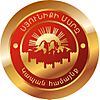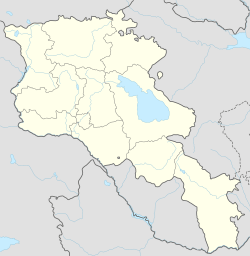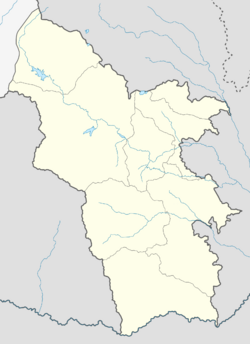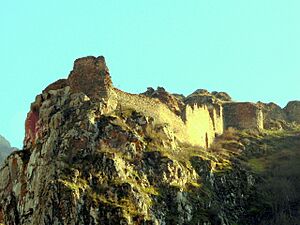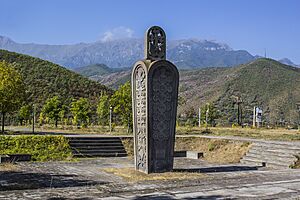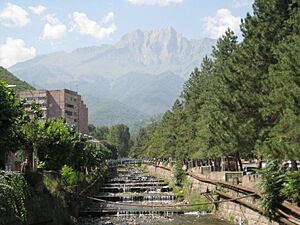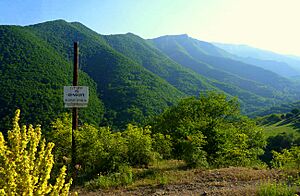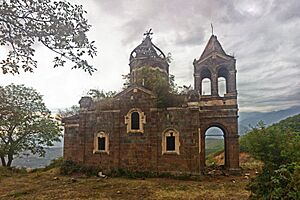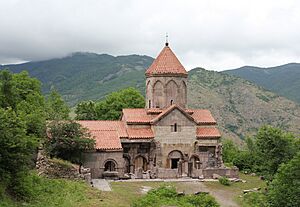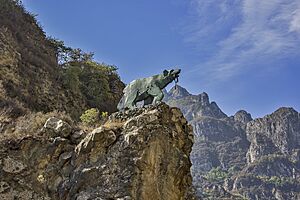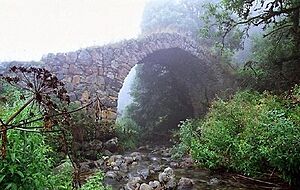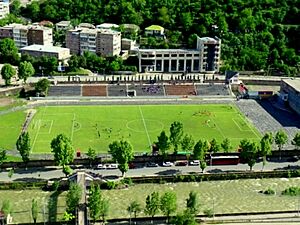Kapan facts for kids
Quick facts for kids
Kapan
Կապան
|
||
|---|---|---|
|
Town
|
||
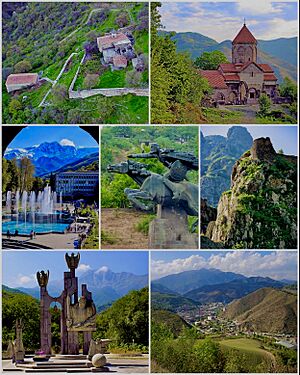
From top left:
|
||
|
||
| Country | ||
| Province | Syunik | |
| Municipality | Kapan | |
| First mentioned | 5th century | |
| City status | 1938 | |
| Area | ||
| • Total | 36 km2 (14 sq mi) | |
| Elevation | 910 m (2,990 ft) | |
| Population
(2011 census)
|
||
| • Total | 43,190 | |
| • Density | 1,200/km2 (3,110/sq mi) | |
| Time zone | UTC+4 (AMT) | |
| Postal code |
3301-3308
|
|
| Area code(s) | (+374) 285 | |
| Website | Official website: http://www.kapan.am/ | |
Kapan (Armenian: Կապան) is a town in southeast Armenia. It is the main city of the Syunik Province. Kapan is located in the valley of the Voghji River. It sits on the northern slopes of Mount Khustup.
Kapan is the biggest town in the Syunik Province. It is also the most populated town in southern Armenia. In 2011, about 43,190 people lived there. By 2023, the population was around 41,300.
Contents
What's in a Name?
The name Kapan comes from an old Armenian word, kapan. This word means "mountain pass." It is related to the word kapel, which means "to tie."
Later, the name changed to Ghap’an. This name was used until 1991. Then, the older name, Kapan, was brought back.
A Look Back: Kapan's History
Early Times and Middle Ages
The area where Kapan is today was first mentioned in the 5th century. It was a small settlement owned by the Siunia dynasty. This area was part of Baghk’, a region in the historic Greater Armenia.
In the late 9th and early 10th centuries, Prince Dzagik built defenses around Kapan. It became his home. By the end of the 10th century, Prince Smbat II of Syunik moved to Kapan. He founded the Kingdom of Syunik there. He became a king under the protection of the Bagratid Kingdom of Armenia.
As the capital, Kapan grew a lot in the 11th century. It had about 20,000 people. Most were Armenians, but there was also a notable Jewish community. Kapan was a busy center for trade, crafts, and metalwork.
In 1103, Seljuk invaders destroyed Kapan. A historian named Stephen Orbelian said the Seljuks started attacking from the Jewish part of Kapan. After the Kingdom of Syunik fell in 1170, the region faced many invasions. These included the Seljuks, Mongols, Aq Qoyunlu, and Kara Koyunlu between the 12th and 15th centuries.
Under Iranian Rule
In the early 1500s, Kapan became part of the Safavid Iran. In 1722, the Armenian principality of Kapan was formed. This united noble families from Syunik. Their goal was to fight against Muslim rule.
In the early 1700s, Kapan was linked to the Armenian military leader David Bek. He led a fight to free the Armenians of Syunik from Iranian and Ottoman Turkish invaders. David Bek started his battles in 1722. He had help from thousands of local Armenians, like Avan Yuzbashi and Mkhitar Sparapet. They took control of Syunik. David Bek's main strongholds were the Baghaberd Fortress and the Halidzor Fortress. He passed away at Halidzor in 1728.
In 1747, Kapan became part of the Nakhichevan Khanate. By 1750, it joined the new Karabakh Khanate. By the end of the 18th century, Kapan grew into an important town under Qajar Iranian rule.
Under Russian Rule
In 1813, the Syunik region, including Kapan, became part of the Russian Empire. This happened after the Russo-Persian War and the Treaty of Gulistan. From 1828 to 1830, many Armenian families moved to the region from Iranian cities like Khoy and Salmast.
In 1868, Kapan became part of the Zangezur uezd within the Elizavetpol Governorate. By the late 1800s, Kapan became an important town. This was because several villages merged together.
Modern History
Between 1918 and 1920, both the Republic of Armenia and the Azerbaijan Democratic Republic claimed Kapan. In December 1920, Armenia became part of the Soviet Union. Kapan was then included in the Republic of Mountainous Armenia. This republic was led by Garegin Nzhdeh. He fought against the Bolsheviks from April to July 1921.
After the Soviet Red Army entered the Zangezur region in July 1921, Kapan became part of the Armenian SSR. In September 1930, the Kafan raion (district) was created, with Kapan as its center. In 1938, Kapan officially became a city. Until 1991, the city was called Kafan in Russian and Ghap’an in Armenian.
After Armenia became independent in 1991, Kapan became the center of the new Syunik Province. This was part of the 1995 administrative changes. Many streets named after Bolshevik figures were changed. The town's main square was renamed after Garegin Nzhdeh. The central park was named after Vazgen Sargsyan.
During the First Nagorno-Karabakh War, Kapan faced attacks from the nearby Zangilan District of Azerbaijan. This caused harm to the people living there. Because of this, Armenian forces took control of some nearby Azerbaijani border villages in December 1992.
Geography and Climate
Kapan is the largest town in the Syunik province. It is also the biggest in southern Armenia. It is in the eastern part of Syunik. The town is in the narrow valley of the Voghji River. This valley is about 13 km long from east to west. Kapan is on the southeastern slopes of the Zangezur Mountains. It is between the Bargushat and Meghri mountain ranges.
The town is about 80 km north of the Iranian border. Mount Khustup is the highest peak in the region, standing at 3201 meters. Kapan is located between 750 and 1050 meters above sea level. Its average height is 910 meters. Two smaller rivers, Vachagan and Kavart, flow through the town. They are tributaries of the Voghji River.
Kapan has a humid continental climate. This means it has very warm summers and cold winters. Summer temperatures can reach up to 38°C. In winter, temperatures can drop to -15°C.
The Shikahogh State Preserve was created in 1958. It is about 14 km south of Kapan, near the village of Shikahogh. This preserve is home to about 1,100 types of plants. Seventy of these plants are listed in Armenia's Red Book, meaning they are rare or endangered. The animals of Shikahogh have not been fully studied. However, rare animals like leopards, wild goats, bears, vipers, and hedgehogs have been found there.
| Climate data for Kapan | |||||||||||||
|---|---|---|---|---|---|---|---|---|---|---|---|---|---|
| Month | Jan | Feb | Mar | Apr | May | Jun | Jul | Aug | Sep | Oct | Nov | Dec | Year |
| Mean daily maximum °C (°F) | 7.1 (44.8) |
8.4 (47.1) |
11.7 (53.1) |
17.1 (62.8) |
21.8 (71.2) |
25.8 (78.4) |
29.3 (84.7) |
29.3 (84.7) |
24.4 (75.9) |
19.8 (67.6) |
13.1 (55.6) |
9.0 (48.2) |
18.1 (64.5) |
| Daily mean °C (°F) | −3.0 (26.6) |
−1.8 (28.8) |
1.9 (35.4) |
8.1 (46.6) |
12.9 (55.2) |
16.9 (62.4) |
20.2 (68.4) |
20.2 (68.4) |
15.7 (60.3) |
10.4 (50.7) |
3.6 (38.5) |
−0.5 (31.1) |
8.7 (47.7) |
| Mean daily minimum °C (°F) | −13.0 (8.6) |
−12.0 (10.4) |
−8.0 (17.6) |
−1.0 (30.2) |
4.0 (39.2) |
8.0 (46.4) |
11.0 (51.8) |
11.0 (51.8) |
7.0 (44.6) |
1.0 (33.8) |
−6.0 (21.2) |
−10.0 (14.0) |
−0.7 (30.8) |
| Average precipitation mm (inches) | 28 (1.1) |
32 (1.3) |
60 (2.4) |
80 (3.1) |
96 (3.8) |
68 (2.7) |
31 (1.2) |
30 (1.2) |
43 (1.7) |
55 (2.2) |
40 (1.6) |
27 (1.1) |
590 (23.4) |
| Source: WMO | |||||||||||||
People of Kapan
Kapan has always been an important center for Armenian culture in Syunik. In the Middle Ages, a large Jewish community lived in its own part of Kapan.
In the early 1800s, many Russian and German engineers and workers came to Kapan. They worked in the copper mines. In 1850, Greek experts also arrived. The Greeks built the Saint Catherine Orthodox church near Kapan in 1865.
Kapan's population was highest in 2001, with 45,711 people. However, the number of people living there has gone down. In 2016, it was estimated to be 34,600.
Today, Kapan is mostly home to Armenians. They belong to the Armenian Apostolic Church. The town's Saint Mesrop Mashtots Church opened in December 2001. It is managed by the Diocese of Syunik of the Armenian Apostolic Church. This diocese is based in the nearby town of Goris.
| Historical population | ||
|---|---|---|
| Year | Pop. | ±% p.a. |
| 1831 | 196 | — |
| 1897 | 2,272 | +3.78% |
| 1926 | 2,658 | +0.54% |
| 1939 | 8,511 | +9.37% |
| 1959 | 19,315 | +4.18% |
| 1976 | 36,351 | +3.79% |
| 2001 | 45,711 | +0.92% |
The Kapan Medical Center serves the town. It was fully updated in 2015.
Culture and Landmarks
The old part of Kapan is about 10 km west of the modern town. Kapan and its surroundings have many old Armenian buildings and sites. These include:
- Baghaberd Fortress from the 4th century. It is also known as the castle of Davit Bek.
- A medieval bridge in Kapan that dates back to 871.
- Tatev Monastery from the 9th century. It was built where an ancient holy place once stood.
- Vahanavank Monastery from the 11th century.
- Halidzor Fortress from the 17th century.
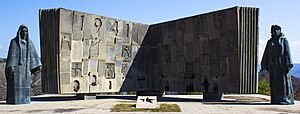
The town has several statues of important Armenian heroes. There is an equestrian (on horseback) statue of Davit Bek from 1983. There is also a memorial to Garegin Nzhdeh from 2001. Other statues include the bear statue of Kajaran's Key (1966) and the Girl from Zangezur (1978). There is a World War II memorial (1987) and a memorial for the Armenian genocide (1988).
Kapan has a Museum of Geology and a history museum named after Shmavon Movsisyan. Other cultural places include the Children's School of Fine Arts (opened 1972) and the House of Culture (opened 1977). There is also a Children's School of Arts (opened 1981), a public library, and a children's and youth creativity center (opened 1990). Kapan also has the Alexander Shirvanzade drama theatre and two music schools (opened 1977 and 1986). A branch of the Modern Art Museum of Yerevan is also in Kapan.
The Wings of Tatev cableway is about 24 km north of Kapan. It connects Halidzor village with the Tatev Monastery. It is the longest reversible aerial tramway built in one section.
Media
Kapan has two local TV channels: Khustup TV and Sosi TV. Khustup TV started in 2004 and covers all of Syunik. Sosi TV started in 2012 and covers the central and southern parts of Syunik.
Getting Around: Transportation
The M-2 main road goes through Kapan. This road connects the capital city, Yerevan, with southern Armenia and the Iranian border.
In late 2008, the road between Kapan and Meghri (on the Iranian border) was improved. The Kapan-Zangilan-Mincivan railway line is not currently in use.
Before the First Nagorno-Karabakh War, the airport near Kapan handled cargo planes. In February 2017, the governor of Syunik Province said the airfield would become a modern airport. It would serve Kapan and southern Armenia. A test landing happened on June 6 with the governor on board. The Kapan Airport was expected to be finished in 2018. It cost about US$2 million. The airport reopened in 2023. It now has flights between Kapan and Yerevan. This makes Kapan the third city in Armenia with an operating airport, after Yerevan and Gyumri.
Kapan's Economy
Kapan is mainly a mining center. Its old Persian name, Ma'dan, means "mine."
Tourism is growing in the Kapan region. The nearby Wings of Tatev cableway has helped a lot. Many new hotels and mountain resorts are planned. The reopening of the Syunik Airport will also bring more tourists. Ark Ecological NGO, based in Kapan, has been working on ecotourism in Syunik since 2013. They are building hiking trails to connect Kapan and the Tatev Monastery.
Learning in Kapan
The Kapan campus of the National Polytechnic University of Armenia has two main departments:
- Faculty of Technologies and Sectoral Economics
- Faculty of Natural Sciences and Communication Systems
Sports
In May 2013, Gandzasar Kapan opened new football fields. One of them has artificial turf. This academy was the first modern football training center in the Syunik Province.
Kapan and the World
Consulates
In October 2022, Iran opened a consulate general in Kapan. In 2023, Russia and France also announced plans to open consulates there.
Twin Towns – Sister Cities
Kapan has special connections with these cities:
 Glendale, California, United States
Glendale, California, United States Borisov, Belarus
Borisov, Belarus
Famous People from Kapan
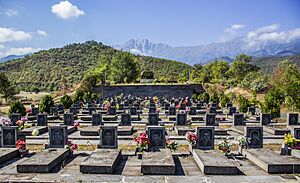
- David Ambartsumyan, a Soviet Armenian diver and European champion.
- Tatoul Markarian, Armenia's ambassador to the European Union.
- Armen Movsisyan, former Minister of Energy of Armenia.
- Karen Sargsyan, main choirmaster of the Armenian Opera Theater.
- Lusine Gevorkyan, lead singer of Russian bands Tracktor Bowling and Louna.
- Artsvik Harutyunyan, singer and Armenia's representative in the Eurovision Song Contest 2017.
- Levon Aghasyan, an Olympic athlete.
- Vardan Ghazaryan, football coach and former player.
Images for kids
See also
 In Spanish: Kapan para niños
In Spanish: Kapan para niños


